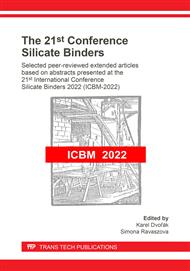p.59
p.67
p.75
p.85
p.97
p.103
p.109
p.115
p.121
The Effect of the Origin and Inner Structure of Limestones on the Burning Process and the Formation of Lime
Abstract:
The burning process of limestones is an important process in the modern industries, which can be described in two parts, CaCO3 decarbonation due to the thermal stress and formation of CaO crystalline structure. It was already observed that the different composition and structure of a raw material influence the transformation process and has affect on the chemical and mechanical properties on the formed lime. This study is focused on the characterization of the raw material (porosity, chemical composition, geological age and origin) and its effect on the burning process and the formation of CaO and its properties. The microstructure of studied material burnt at different times of isothermal load was observed by SEM and the reactivity test was measured and analyzed. The limestone with a more porous inner system was burnt faster and is inclinable to overburn at longer thermal load.
Info:
Periodical:
Pages:
121-126
Citation:
Online since:
October 2023
Authors:
Price:
Сopyright:
© 2023 Trans Tech Publications Ltd. All Rights Reserved
Share:
Citation:



